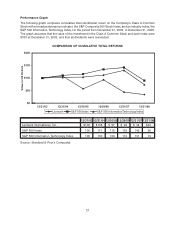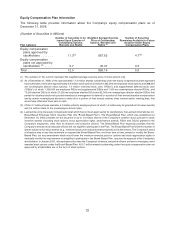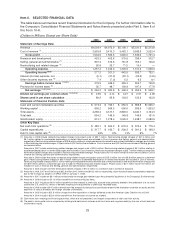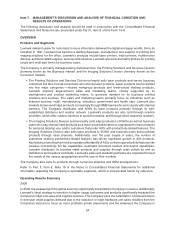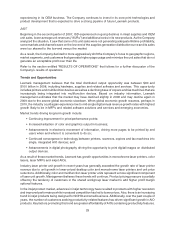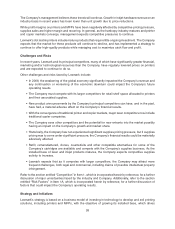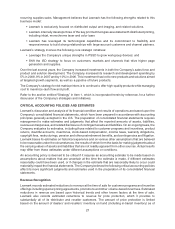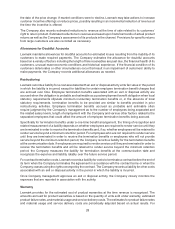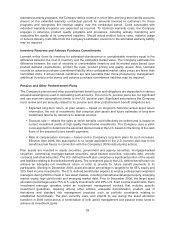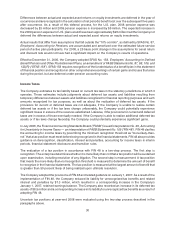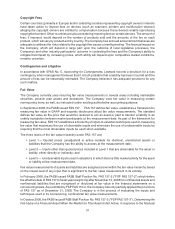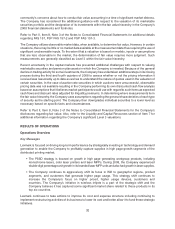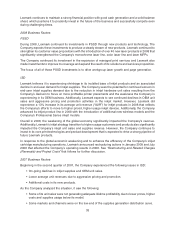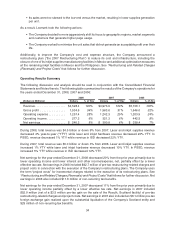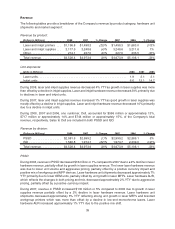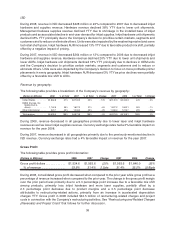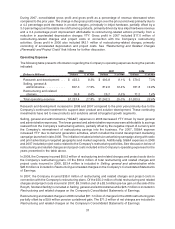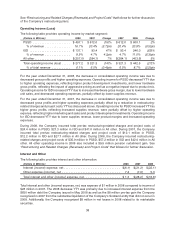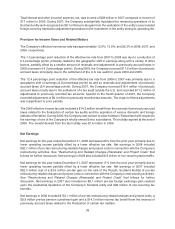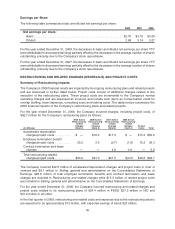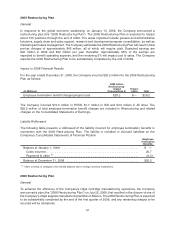Lexmark 2008 Annual Report Download - page 37
Download and view the complete annual report
Please find page 37 of the 2008 Lexmark annual report below. You can navigate through the pages in the report by either clicking on the pages listed below, or by using the keyword search tool below to find specific information within the annual report.Copyright Fees
Certain countries (primarily in Europe) and/or collecting societies representing copyright owners’ interests
have taken action to impose fees on devices (such as scanners, printers and multifunction devices)
alleging the copyright owners are entitled to compensation because these devices enable reproducing
copyrighted content. Other countries are also considering imposing fees on certain devices. The amount of
fees, if imposed, would depend on the number of products sold and the amounts of the fee on each
product, which will vary by product and by country. The Company has accrued amounts that it believes are
adequate to address the risks related to the copyright fee issues currently pending. The financial impact on
the Company, which will depend in large part upon the outcome of local legislative processes, the
Company’s and other industry participants’ outcome in contesting the fees and the Company’s ability to
mitigate that impact by increasing prices, which ability will depend upon competitive market conditions,
remains uncertain.
Contingencies and Litigation
In accordance with SFAS No. 5, Accounting for Contingencies, Lexmark records a provision for a loss
contingency when management believes that it is both probable that a liability has been incurred and the
amount of loss can be reasonably estimated. The Company believes it has adequate provisions for any
such matters.
Fair Value
The Company currently uses recurring fair value measurements in several areas including marketable
securities, pension plan assets and derivatives. The Company uses fair value in measuring certain
nonrecurring items as well, as instructed under existing authoritative accounting guidance.
In September 2006, the FASB issued FAS 157. FAS 157 defines fair value, establishes a framework for
measuring fair value in GAAP and expands disclosures about fair value measurements. The standard
defines fair value as the price that would be received to sell an asset or paid to transfer a liability in an
orderly transaction between market participants at the measurement date. As part of the framework for
measuring fair value, FAS 157 establishes a hierarchy of inputs to valuation techniques used in measuring
fair value that maximizes the use of observable inputs and minimizes the use of unobservable inputs by
requiring that the most observable inputs be used when available.
The three levels of the fair value hierarchy under FAS 157 are:
• Level 1 — Quoted prices (unadjusted) in active markets for identical, unrestricted assets or
liabilities that the Company has the ability to access at the measurement date;
• Level 2 — Inputs other than quoted prices included in Level 1 that are observable for the asset or
liability, either directly or indirectly; and
• Level 3 — Unobservable inputs used in valuations in which there is little market activity for the asset
or liability at the measurement date.
Fair value measurements of assets and liabilities are assigned a level within the fair value hierarchy based
on the lowest level of any input that is significant to the fair value measurement in its entirety.
In February 2008, the FASB issued FASB Staff Position No. FAS 157-2 (“FSP FAS 157-2”) which defers
the effective date of FAS 157 to fiscal years beginning after November 15, 2008 for nonfinancial assets and
nonfinancial liabilities that are recognized or disclosed at fair value in the financial statements on a
nonrecurring basis. As permitted by FSP FAS 157-2, the Company has only partially applied the provisions
of FAS 157 as of December 31, 2008. The Company is in the process of evaluating the inputs and
techniques used in its nonrecurring, nonfinancial fair value measurements.
In October 2008, the FASB issued FASB Staff Position No. FAS 157-3 (“FSP FAS 157-3”), Determining the
Fair Value of a Financial Asset When the Market for That Asset Is Not Active, in response to the financial
31


